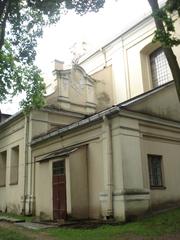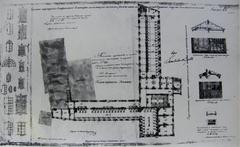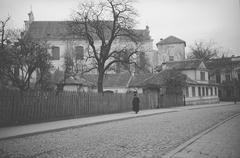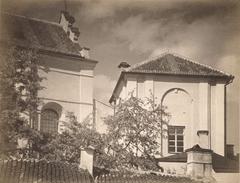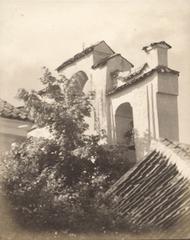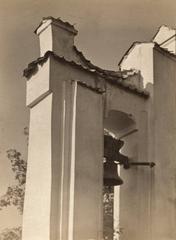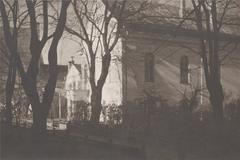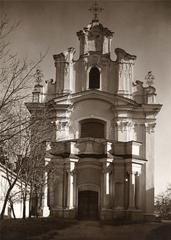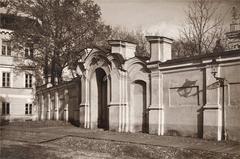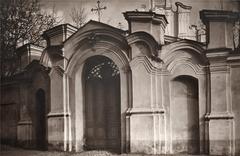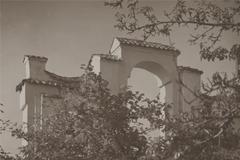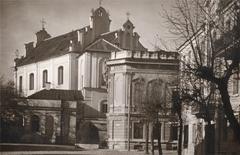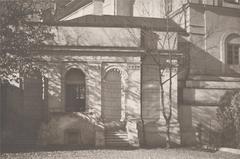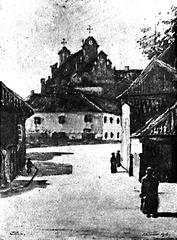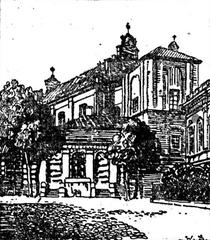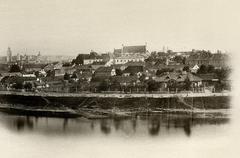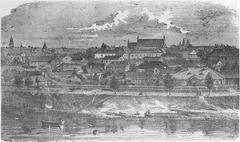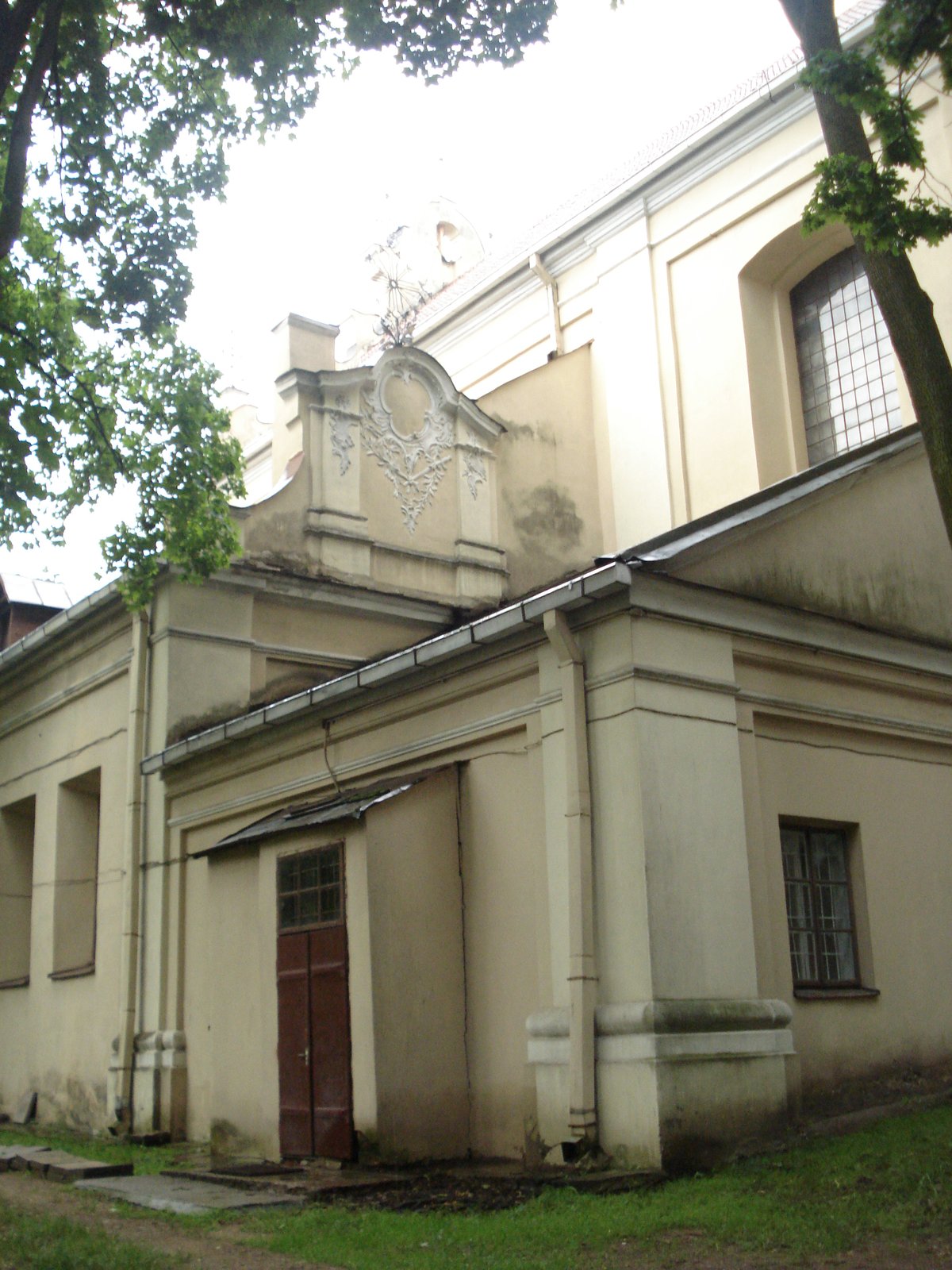
Church of St. George Vilnius: Visiting Hours, Tickets, and Historical Guide
Date: 15/06/2025
Introduction
The Church of St. George in Vilnius stands as a testament to Lithuania’s rich religious and cultural tapestry. Located in the heart of Vilnius Old Town—a UNESCO World Heritage site—this historic church invites visitors to explore centuries of spiritual devotion, architectural transformation, and cultural resilience. Founded in the 16th century as part of Lithuania’s first Carmelite monastery of the Old Rule, the church has witnessed the city’s evolution from its Gothic origins to a Baroque revival following 18th-century devastation (cityofmercy.lt).
Today, the Church of St. George is celebrated for its ornate Baroque architecture, rare frescoes, and significant historical roles—serving as a seminary and, during wartime, a sanctuary for cultural artifacts (truelithuania.com; jerulita.com). While the interior remains closed due to ongoing preservation, the church’s exterior is a highlight of Vilnius walking tours, reflecting its lasting spiritual and multicultural significance (vilnius-tourism.lt).
This guide details the Church of St. George’s history, architectural significance, practical visitor information—including hours, tickets, and accessibility—and travel tips. Whether you are an architecture enthusiast, history buff, or cultural traveler, this article provides essential knowledge to enrich your visit to one of Vilnius’s most treasured landmarks. For the latest updates and virtual tours, consult official tourism resources and local guides (govilnius.lt; vilnius-events.lt).
Table of Contents
- Early Foundations and Gothic Origins
- Destruction and Baroque Rebirth
- From Seminary to Cultural Repository
- Architectural and Artistic Highlights
- Visiting Information: Hours, Tickets, Accessibility
- Guided Tours and Special Events
- Nearby Attractions and Travel Tips
- Visitor Etiquette and Photography
- Accessibility for Visitors with Disabilities
- Frequently Asked Questions (FAQ)
- Conclusion and Recommendations
- Further Reading and Official Resources
1. Early Foundations and Gothic Origins
Established in the 16th century, the Church of St. George was initially part of the first Carmelite monastery of the Old Rule in Lithuania (cityofmercy.lt). The Carmelites, a Catholic mendicant order, played a crucial role in shaping Vilnius’s religious and intellectual life. The original church, built in the Gothic style, featured pointed arches and ribbed vaults, echoing the architectural language seen in other iconic Vilnius churches like St. Anne’s and St. John’s (truelithuania.com).
Vilnius in the 16th century was a melting pot of religious communities—Roman Catholic, Orthodox, and Jewish—each contributing to the city’s architectural and cultural diversity (lrt.lt). The construction of the Church of St. George underscored both the Catholic Church’s growing influence and the city’s openness to new religious orders.
2. Destruction and Baroque Rebirth
The original Gothic church suffered devastating fire damage in the 18th century, a fate shared by many of Vilnius’s historic buildings. The church was subsequently rebuilt in the late Baroque style, aligning with contemporary architectural trends in the Grand Duchy of Lithuania. Architects like Johann Christoph Glaubitz, prominent in Vilnius’s Baroque transformation, influenced this era of ecclesiastical architecture (lrt.lt).
The Baroque reconstruction introduced elaborate facades, stucco work, and dynamic spatial compositions. The architectural ensemble expanded to include a bell-tower gate and monastery facilities, forming a cohesive and visually striking complex (cityofmercy.lt).
3. From Seminary to Cultural Repository
In the late 18th century, the church and monastery were transferred to the Vilnius seminary for priests, which became a major center for theological education until World War II. The seminary’s merger with Vilnius University’s Faculty of Theology in the 1920s fostered intellectual and spiritual leadership in Lithuania (cityofmercy.lt). Blessed Michał Sopoćko, a notable professor and spiritual director, emphasized charity and left a lasting legacy.
During and after World War II, the church’s purpose shifted dramatically. Soviet authorities closed it for worship and repurposed it as a “House of Books”—a repository for banned and salvaged publications, including those from the Jewish ghetto and cultural organizations. At its peak, the collection numbered around 3 million volumes, symbolizing resistance to cultural erasure (cityofmercy.lt). The collection eventually moved to the Martynas Mažvydas National Library, preserving this legacy for future generations.
4. Architectural and Artistic Highlights
Exterior Features
The church’s Baroque facade is characterized by harmonious proportions, sculpted saints, and intricate stonework (jerulita.com). Pilasters, cornices, and an ornate portal create a sense of grandeur. Contrasting materials—pale plaster and red brick—enhance its visual impact, while the bell tower adds vertical emphasis.
Interior Design
The nave, with its high vaulted ceilings and rare frescoes, evokes Baroque opulence and spiritual symbolism. The main altar, flanked by Solomonic columns, often features a dramatic painting or sculpture of St. George slaying the dragon. Side chapels, stained glass windows, and abundant stucco decoration enrich the interior (govilnius.lt).
Artistic Heritage
The church is renowned for its rare frescoes depicting the life of St. George and its collection of liturgical objects—carved, gilded, and crafted with exceptional skill (commons.wikimedia.org). These works blend local and European artistic traditions.
5. Visiting Information: Hours, Tickets, Accessibility
Current Status:
- As of June 2025, the Church of St. George is closed for regular worship and interior visits due to preservation work.
- The exterior is freely viewable and included in many Old Town walking tours.
Typical Visiting Hours (when open):
- Monday to Friday: 10:00–17:00
- Saturday: 10:00–15:00
- Sunday: Closed
- Check official sources for updates before your visit.
Tickets:
- Admission is free. Donations are welcome to support preservation efforts.
Accessibility:
- The church is accessible on foot and by public transport. Wheelchair access is available at the main entrance when the church is open, with seating for those with mobility needs. Due to renovations, interior access may be restricted.
6. Guided Tours and Special Events
Guided tours are available on weekends and by appointment, offering in-depth exploration of the church’s history and art. Seasonal concerts and occasional religious ceremonies are held, providing unique cultural experiences. The church is featured in the “Way of Mercy” walking route—a spiritual and cultural pathway through Vilnius (cityofmercy.lt).
7. Nearby Attractions and Travel Tips
The Church of St. George is ideally located for exploring Vilnius’s historic core. Key nearby attractions include:
- St. Anne’s Church (Gothic masterpiece)
- Vilnius University (historic courtyards, library)
- Presidential Palace
- Gates of Dawn (iconic pilgrimage site)
- Bernardine Garden (peaceful park)
- St. Casimir’s Church (Baroque architecture)
Travel Tips:
- Wear comfortable shoes for cobblestone streets.
- Visit early morning or late afternoon for the best light and fewer crowds.
- Check the Vilnius Events Calendar for concerts or special events.
8. Visitor Etiquette and Photography
- Dress Code: Modest attire is required; shoulders and knees should be covered.
- Behavior: Maintain silence, especially during services or prayer times.
- Photography: Generally permitted (no flash), but respect any restricted areas and ongoing services (Trip101).
9. Accessibility for Visitors with Disabilities
The historic architecture presents some challenges; while the main entrance is accessible when open, interior areas may have uneven flooring and limited ramps. Contact the church or Vilnius Tourist Information Centre ahead of your visit for current accessibility provisions.
10. Frequently Asked Questions (FAQ)
Q: Can I enter the Church of St. George?
A: Currently, the interior is closed due to conservation. The exterior can be admired during walking tours.
Q: Are guided tours available?
A: Yes, many city tours include the church, and specialized tours may be arranged.
Q: Is there an entrance fee?
A: No; the exterior is free to view, and donations are appreciated if the interior reopens.
Q: Is the church wheelchair accessible?
A: The exterior is accessible; interior accessibility depends on ongoing restoration.
Q: Can I take photos?
A: Yes, but without flash and with respect for any posted restrictions.
11. Conclusion and Recommendations
The Church of St. George in Vilnius embodies Lithuania’s religious, artistic, and cultural endurance. From its Gothic origins to Baroque splendor and its pivotal role as a wartime book repository, the church’s story is one of resilience. While interior access is currently restricted, its stunning exterior and layered history make it a must-see on any tour of Vilnius Old Town. Combine your visit with nearby landmarks for a full exploration of the city’s heritage, and consider joining a guided tour for deeper insight. Support preservation efforts through donations, and stay informed about reopening by following official tourism channels.
12. Further Reading and Official Resources
- Church of St. George in Vilnius, City of Mercy
- Churches of the Vilnius Old Town, True Lithuania
- Vilnius Architecture from Baroque to Modernist, Jerulita
- Vilnius and Its 700-Year History: Key Dates, LRT
- Visit Vilnius – Churches and Pilgrimage, Go Vilnius
- Official Vilnius Tourism Website
- Vilnius Events – Tourist Information
- In Lithuania – Visitor Guides
